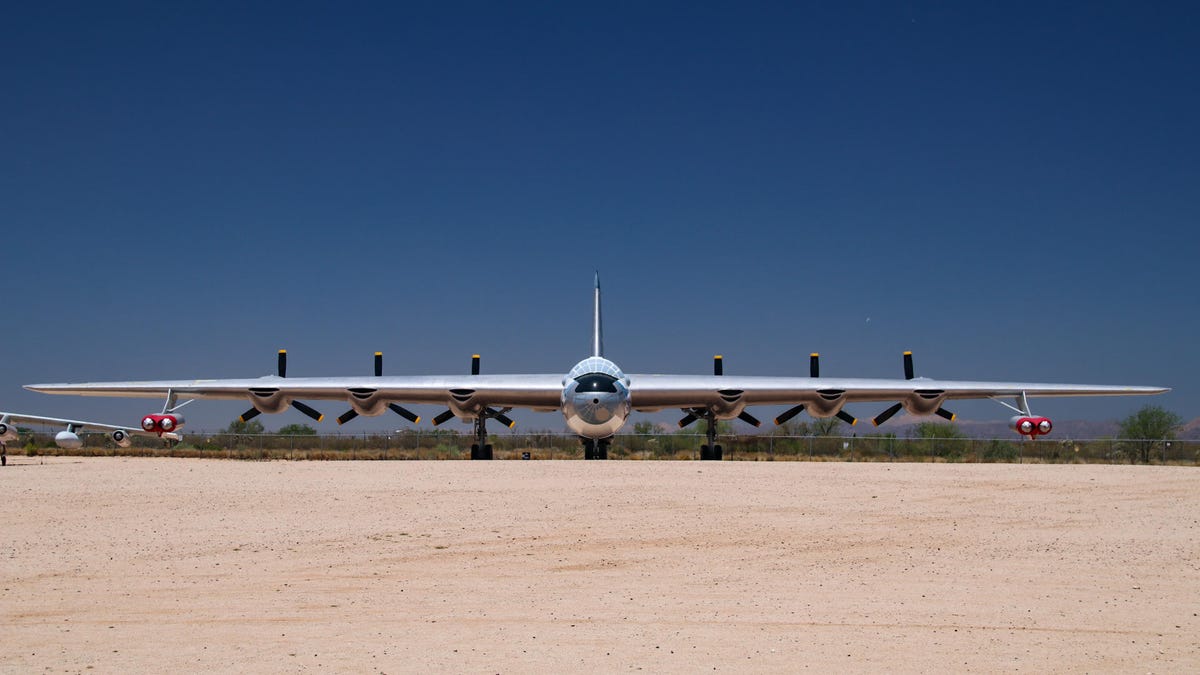 Why You Can Trust CNET
Why You Can Trust CNET A vast oasis of aircraft lies deep in the Arizona desert
The incredible Pima Air and Space Museum is home to dozens of legendary aircraft, like the B-52, the SR-71 Blackbird, the B-17, and more. Here are more than 50 photos to take you there.

I love big airplanes.
There aren't many places where you can see them, though. Each bomber is massive, and most air museums have finite space. Except for one: Pima. Surrounded by the Arizona desert, the Pima Air and Space Museum has the perfect climate for long-term outdoor aircraft storage. The hard ground, nearly as hard as concrete, makes it an ideal location.
This amazing museum has more than just bombers, however. Fighter aircraft from WWII, Korea, Vietnam and newer populate this amazing museum as well. There are some real rarities, like a B-36, multiple B-52s, an SR-71 and even a MiG-29.
I spent a day exploring. Join me, won't you?
Desert aircraft oasis
Unless you live in Tucson, Pima isn't exactly easy to get to. It's about the same distance to New Mexico as it is to Phoenix, and even closer still to Mexico. Parking spaces covered by solar panels are like a gift to visitors, so their cars aren't 1,000 degrees inside when they return to them.
About a third of the museum is inside, and that's where you start. An SR-71 Blackbird and D-21 mini-drone are looking right at you when you enter. A rarity next to a rarity. This eclectic first hanger also houses the beautiful-in-its-way A-10, a BD5-J like the one in "Octopussy," and the fastest production helicopter, the Westland Lynx.
You need to go outside to get to the other hangars, and to see the really big aircraft. I made a beeline to one of my favorite airplanes, one I've never seen before in person: the B-36. Built in that transition period between props and jets, the "Peacemaker" has both. With six propellers (rear facing!) and four jet engines, the B-36 is one strange-looking aircraft. It's smaller than I pictured, though part of that could be because it's sitting next to a B-52, the aircraft that essentially superseded it, give or take a B-47 or several (there's one of those here, too).
The variety out here under the fierce sun is impressive. A P-3 Orion, an Avro Shackleton, a Super Guppy, a C-130, and even a Boeing 787, one of the few planes here still in flyable condition. As I work my way along the long line of planes, a pair of airworthy A-10s fly maneuvers in the sky above.
The other hangars house more delicate historical aircraft. One is devoted entirely to a B-17. Another houses a B-29 and a few other WWII- and Korean War-era aircraft. Another of my favorites, a Catalina, shares a hangar with a PB4Y and B-25.
A DC-10 sits outside next to these hangars, its engine's fan blades squeaking eerily in the hot desert wind.
Everywhere, though, in row upon row upon row, are fighters from throughout the jet age. From F-15s and F-4s, to Thunderchiefs and Aardvarks, to F-86s and F-8s.
And if all that weren't enough, in one corner are a bevy of helicopters, including a Russian Hind and a bulbous Sikorsky H-37B Mojave.
This is easily one of the best air museums I've ever visited, and I've visited a lot.
If you visit Pima, make sure to schedule some time for AMARG, aka the Boneyard, where hundreds of decommissioned aircraft await their unknown fate. I did that tour, too. It was amazing.
Pima is open 7 days a week, from 9 to 5, except Christmas and Thanksgiving. Entrance is $15.50, less for kids, plus an additional $7 for an AMARG tour. Both are a must for any airplane fanatic (especially if you love big bombers).
If you make the drive, don't miss the nearby and fascinating Titan Missile Museum.
As well as covering audio and display tech, Geoff does photo tours of cool museums and locations around the world, including nuclear submarines, aircraft carriers, medieval castles, epic 10,000-mile road trips and more.
Also check out Budget Travel for Dummies, his travel book, and his bestselling sci-fi novel about city-size submarines. You can follow him on Instagram and YouTube.

